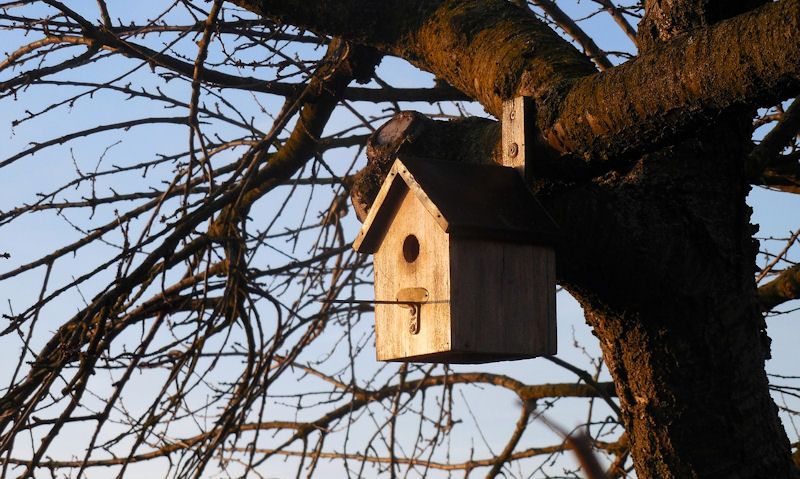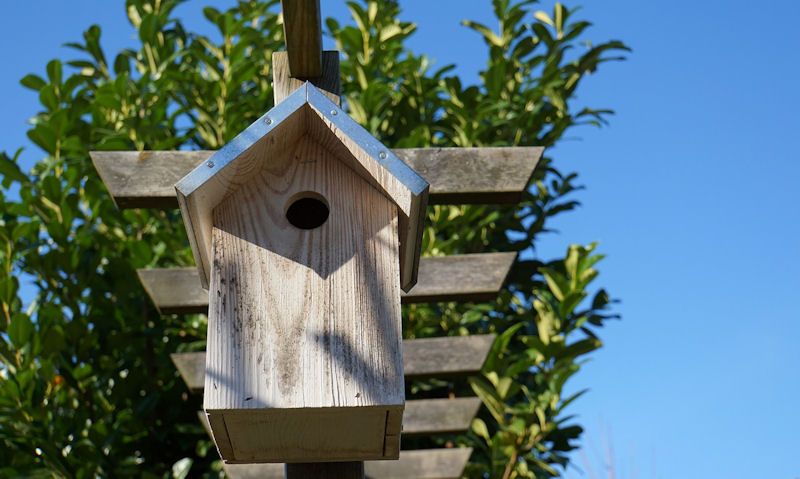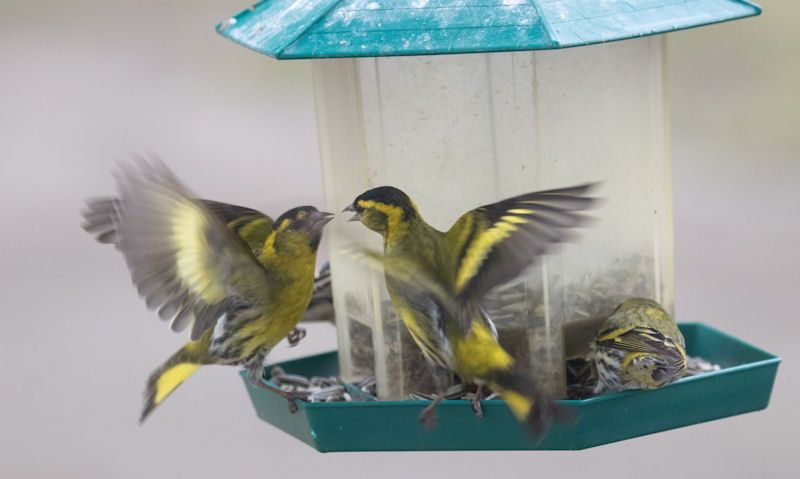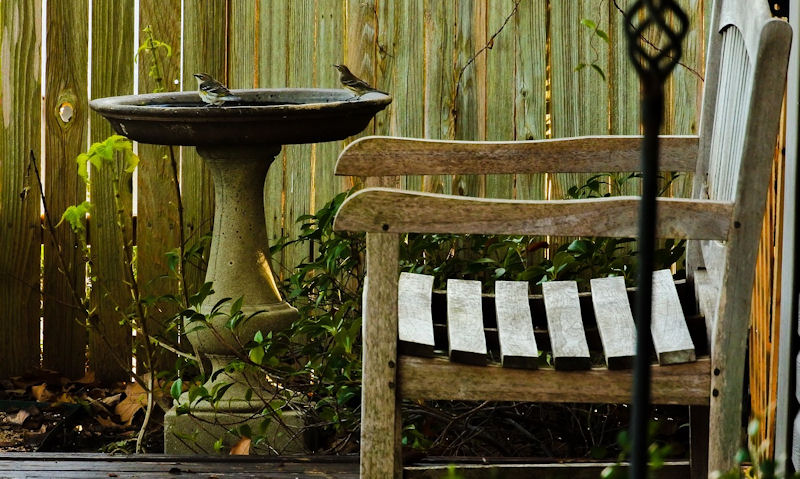Which way should a bird box face
Wrongly facing a bird box towards the south/west will have severe consequences for the occupants, well setting up a box facing north/east should be taken seriously.
Setup all open to the element bird boxes in the direction of the north/east, or anywhere in between. Avoid direct sunlight by setting up in a shaded area if you must face the box in the south/west. Natural cover comes from buildings and tree's, well the sun, winds and cold chill should be avoided.
Limit the strength of the sun, the strongest winds and the coldest chill hitting full on the bird box by facing towards the north and east.
Whichever direction you face a bird nesting box it will still attract chilly winds and rain, but you should do your best to keep it covered from the sun.
Shaded areas in your garden with nearby tree and building cover would make the best location to site a box, though wooded areas or deeper in the woods is better still.
When we attract birds to nest in our bird boxes we are responsible for them.
An incorrectly positioned bird box can make them suffer, which is especially true for the young hatchlings or eggs that haven't been hatched yet.
To be faced with struggling birds in the box would be devastating for anyone, so know that actions have consequences.
Stop this ever happening by facing the bird box north or east, and anywhere in between.
Pay close attention to the advice we've outline below, as we offer you lots of vital and interesting ideas to set up a bird box in a safe environment that will last.
Its illegal to move a bird box well occupied, so if you have a box setup that has nesting or roosting birds, you can do one of two things right away.
Prop up cover to create shade that covers the box, and well this may be hard as to what item to use to cover the box, there's one idea that works the best.
Use a big square or rectangle shaped plank of plywood or MDF and rest it on top of the bird box. To keep it secure use a brick or heavy stone but always make sure the box can withstand the extra weight.
Do all this well not disturbing the birds inside, a little noise is fine, but make it short and swift with a plan of action.
North/East facing
When setting up a bird nesting box always make sure is facing in the direction of north or east, or anywhere in between.
As recommended by all wildlife experts, including the RSPB - and with a little common sense - this will keep the box facing away from the sun, wet and wind.
Directly facing the box north or east is not a possibility, but thankfully you're allowed wiggle room as its possible to face the box anywhere in between.
Though if you can, a near perfect north/east direction would be better suited, but not necessary.
If facing your box the wrong way already, its possible it would be hit with harshest conditions the British weather can throw at it.
With strong sun a real problem, followed by chilly winds and rain.
- Sun - direct sunlight should always be kept off the box as the conditions within the box turns to a furnace, probably killing the young inside the box.
- Wind - the prevailing winds come from the south/west, hence the reason to face the box the other way, and where there's a wind here comes the chill...
- Chill - caught up in the prevailing winds during the coldest months comes the wind chill, which could pass through the entrance hole well passing through the ventilation holes on the bottom of the box.
Well all these conditions happen during the warmer mouths, its a real killer during the autumn/winter.
Finding the correct direction
If you're someone who doesn't know from east to west, south to north; then you should probably find out before committing to setting up a box.
All you need to know is which direction is north/east where you wish to site the box.
To do this you can do one of three things...
Simply download a compass app on your phone and use that to fix your position. The compass will keep its position well you move around to face north or east, or anywhere in between is perfectly acceptable.
Another one is to head into a town or a nearby church and see which way the weathervane is pointing.
If you can figure out which direction is still pointing once arriving back to your house or wherever the box is to be located, then use this method, but there is a chance you will get turned around and mess it all up.
And finally, and what we would recommend is to simply use Google Maps online.
Here you can type in your postcode before strolling into your destination and see which way your house or site is located.
Always remember the top of the screen is always facing north, well the bottom is south.
Switch Google Maps from roadmap view over to Streetmap to view you area in a full high definition photography, you'll then get a better understanding of the landscape.
Out of direct, strong sunlight

Setting up a bird box must always be in an area that keeps the direct sun hitting the box all day long.
So with that in mind, where you site a bird box is almost as important where you place the box for the bird species in question.
For bird nesting boxes to be setup for those common small wild birds that nest or roost in our garden, its takes some working out.
However, for all setup's in built up areas with lots if tree's, or better still deep in the woodlands, the shade pretty much keeps the sun away.
Always consider the placement of a bird box for each bird in its own recommended spot, but still consider the direction of the sun as it moves across the sky throughout the day.
Robin or Wren boxes for example are usually settled lower down behind plantation, and well this might create natural shade for the birds, the sun could still penetrate through.
Chilly, wet winds
All wind in the UK comes from the west or south/west, thus the reason why a bird box should be facing the opposite way.
Known as prevailing winds, they arrive from the Atlantic picking up moisture along the way, resulting in downpours over Britains during the winter months.
This of course can be chilly winds that are horrible conditions for us, but even worse for nesting or roosting birds in little wooden boxes.
Bird boxes are made with an entrance hole from 25mm up to a whopping 120mm open gap, so the wind is always going to enter the hole regardless.
Its made more difficult as all well made bird boxes have a ventilation hole to prevent the built up of moisture, so now the cold wind can pass through one hole and out the other.
Under no circumstances should you ever cover up these holes.
To beat the winds, always make sure the box is facing north/east; and well you can't avoid the changing wind direction, it would for the most part keep the wettest, chilliest winds away from the box setup.
If the box is in a shaded area, you could help protect the box from chilly winds, so make sure when you setup setup the bird box, you take it seriously.
Keep bird boxes in shade
Did you know you can face a bird box in any direction you desire, without bringing harm to the birds that nest inside.
And that's only made possible if you position the bird box in the shade.
If you must place the box towards the south/west there are lots of natural cover that would create a shaded area for the whole day.
Though going down this route you must make sure the shade cover stays put through the whole day; as the sun spins across the sky the shade moves with it, thus opening up the box to strong sun later on.
If setting up a bird box in the garden, a big thriving tree in the next door neighbours garden or your own would make the perfect conditions for a bird box setup.
And that's providing the tree is in full bloom during the spring/summer months with no way for the sun to shine through well hitting the box for long periods in the day.
Well a tree would make the most appropriate conditions, a tall hedgerow would also be significant enough.
Built up terraced houses are limited with shaded areas as the adjoining home don't protrude out but rather line up perfectly side by side.
So in that case you may only be able to rely on what's on offer in the garden.
If its a semi-detached home, you should have both the front and backside of the house, with the options of the side of the home you could face the box.
If any direction keeps the sunlight away, then fixing the box to the home is ideal.
If your shade relies on buildings and tree in the far distance, know that this would only create limited cover for a short period in the day.
What you're looking out for in shade cover is close up trees or buildings as it creates a wider shaded area with the sun unable to get behind.
Occupied South/West facing box
So you setup a bird box already and is already occupied by a bird, only there's one problem... its a South/West facing box.
Now that you've learned bird boxes shouldn't be facing this direction what can you, especially if there are hatchlings or eggs within the box.
This wooden box becomes a furnace during the warmer months as it takes the full strength of the sun all day long.
To be frank, there's little you can do to protect the occupants as it is illegal to move the bird box which should only be removed professionally, under certain circumstances.
In many cases bird boxes are fixed facing the wrong way around the UK all the time, with people often not knowing, or not really caring the direction the box faces.
And to be honest, most hatchlings or young birds (including the male and female adults) thrive regardless of the direction.
However, you shouldn't use this misunderstood information by keeping things as are, you know better so let's try and improve the conditions within the box.
For example, and it may not apply to many people; if its possible you could setup up an object of sorts to create some sort of shadow for the hottest hours in the day.
This is a difficult solution because not only is it impossible find and setup such an item, but it could result in the item obstructing the entrance hole and there clear line of flight.
If that's not possible, as quietly as you can, fix a large, protruding piece of plywood or MDF an inch or two above the box, thus creating an instant cover with shade.
Under curtain circumstances, and if you're quiet doing it, perhaps you could squirt wood glue on the box roof, place the wood plank on top and set a heavy brick or stone on top until the glue trees.
Doing it this way avoids creating a lot of noise outside the box well keep it to a minimum.
Summary
Make sure your bird box is fixed to a wall or fence in the direction that is always facing away from the sun during the day.
It only takes a day to understand where the sun travels in the sky throughout, so knowing this before fixing a box would be a good start.
If at anytime the box is in direct contact with the sun this could slowly heat up the box before killing or harming the birds within.
So keep it out of the sun at all times well you'll also benefit from keeping the box facing away from the wettest, chilliest winds.
If the box you setup is facing the wrong way already, fix something to create a shaded area, though the best option would be to fix a plank of wood above or directly on top of the box to create a shadow that covers the whole box.
It is illegal to move a bird box well its has nesting or roosting birds inside.


